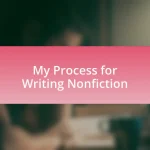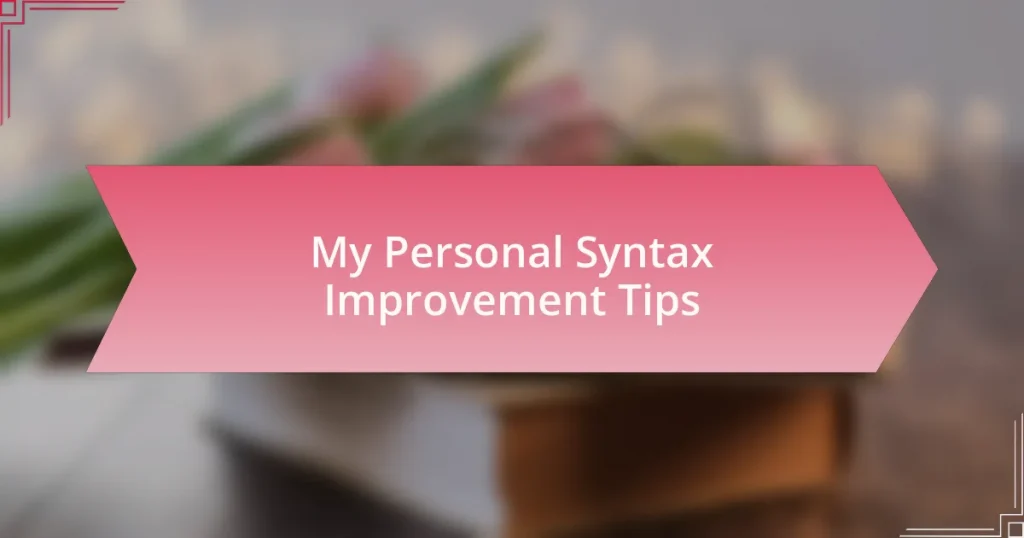Key takeaways:
- Understanding and improving syntax enhances clarity and precision in writing, leading to more effective communication.
- Common mistakes to avoid include sentence fragments, overuse of passive voice, and misplaced modifiers, which can confuse readers.
- Techniques for improvement involve reading sentences aloud, simplifying ideas, and experimenting with sentence variety to engage readers better.
- Reflecting on your writing progress helps identify growth and reinforces learning, promoting confidence in your writing abilities.
Author: Clara Whitfield
Bio: Clara Whitfield is a captivating storyteller and acclaimed author known for her rich, character-driven narratives that explore the complexities of human relationships. With a background in psychology and a passion for literature, Clara weaves intricate plots that resonate with readers on multiple levels. Her debut novel, “Echoes of the Heart,” received critical acclaim and was a finalist for several literary awards. When she’s not writing, Clara enjoys hiking in nature, experimenting in the kitchen, and engaging with her vibrant community of fellow writers. She resides in Portland, Oregon, where she draws inspiration from the lush surroundings and eclectic culture.
Understanding Syntax in English
Syntax in English refers to the structure of sentences—how words combine to convey meaning. I remember grappling with complex sentences as a student; I often over-complicated my writing. Have you ever felt that your thoughts got lost in a jumble of words? The beauty of syntax lies in its ability to create clarity and express nuanced ideas if used correctly.
When I started to pay attention to sentence structure, I found that varying sentence length and style made my writing more engaging. For example, mixing short sentences with longer, more complex ones keeps the reader on their toes and maintains interest. Have you noticed how a well-structured sentence can evoke a certain emotion? It’s fascinating how the placement of just a few words can change the rhythm and impact of a message.
Understanding syntax also involves recognizing different sentence types like declarative, interrogative, and imperative sentences. Each serves a distinct purpose in communication. I recall a particularly impactful moment when I realized how a simple question could tug at a reader’s curiosity—what are you trying to convey in your writing? That awareness transformed how I approached not just syntax but the entire writing process.
Importance of Syntax Improvement
When I think about the importance of syntax improvement, I realize how crucial it is for effective communication. I once wrote a heartfelt email that fell flat because I neglected sentence structure. The recipient didn’t grasp my emotions as intended, leaving me wondering—how can we share our thoughts if our syntax fails to deliver?
Improving syntax fosters precision and clarity in writing. I remember revising a pivotal essay where I stripped away convoluted phrases. The result? A message that resonated more powerfully, transforming my writing from confusing to compelling. Have you ever experienced a moment where clear expression made all the difference? It’s exhilarating to see how careful attention to syntax can enhance understanding.
Moreover, mastering syntax opens doors to personal style and creativity. I used to feel confined by traditional sentence structures, but as I experimented with syntax, I discovered a unique voice. This exploration not only enriched my writing but also made it more enjoyable. Wouldn’t you agree that finding your own rhythm can elevate your work?
Common Syntax Mistakes to Avoid
One common syntax mistake I often see is the misuse of fragments. I once saw a writer submit a piece filled with what I thought were incomplete thoughts. It confused readers and diluted the impact of the argument. Have you ever encountered a sentence that just didn’t feel complete? It’s essential to ensure that each idea is fully expressed, creating a clearer connection with your audience.
Another frequent pitfall is the overuse of passive voice. Early in my writing journey, I relied heavily on passive constructions, thinking it sounded more sophisticated. However, I quickly realized that this often obscured who was responsible for the action. Instead, embracing the active voice not only brings clarity but also adds energy to your writing. When was the last time you revisited your verb choices?
Lastly, I’ve noticed that misplaced modifiers can lead to some amusing misunderstandings. There was a time I wrote, “I saw the dog running down the street with the red collar,” only to have someone interpret it as if the street was wearing the collar! Precision in modifiers can save us from awkward situations and misinterpretations. Don’t you think it’s worth the small effort to ensure your descriptions hit the mark?
Techniques for Improving Your Syntax
Improving your syntax can be a game changer in conveying your message clearly. One technique I’ve found incredibly effective is to read my sentences aloud. This practice helps me identify awkward phrasing or overly complex structures. Have you ever felt that a sentence just doesn’t sound right when spoken? Trust your ear; it can be a reliable guide to clarity.
Another approach is to simplify your sentences. Early on, I often crammed too many ideas into one sentence, thinking it would showcase my knowledge. But I learned that brevity enhances understanding. By breaking down complex ideas into digestible bits, I engage my readers more effectively. Have you tried writing one idea per sentence? You might be surprised by how much clearer your points become.
Finally, experimenting with sentence variety has transformed my writing style. I once relied heavily on long, winding sentences that often lost my readers along the way. Now, I mix short, punchy statements with longer, more descriptive ones. This balance keeps the reader’s interest while allowing significant ideas to shine. How does your writing style reflect your personality? Exploring different structures can reveal new facets of your voice.
Personal Strategies for Syntax Enhancement
One of my go-to strategies for enhancing syntax is to jot down a rough draft without worrying about perfection. I remember the first time I just let my thoughts flow freely; it was liberating. Once the ideas are out, I then revisit and refine my sentences, focusing on clarity and structure. Have you ever found that the initial rush of writing often reveals your true voice?
Another technique involves using transition phrases to connect my thoughts seamlessly. When I learned to employ transitions, it felt like discovering a missing puzzle piece in my writing. It transforms choppy ideas into a fluid narrative that guides the reader effortlessly. How often do you consciously think about how your sentences link together? Engaging transitions can elevate your writing from a list of facts to a cohesive story.
Lastly, I always keep a list of strong verbs and adjectives handy. These powerful words can inject life into my sentences, making them more dynamic. I used to think that adjectives were the key to great writing, but I’ve realized that precise verbs often hold the real magic. When was the last time a word truly transformed how you felt about a piece of writing? Embracing vivid language has opened up new avenues in my expression.
Resources for Syntax Practice
When it comes to resources for practicing syntax, I’ve found that engaging with grammar-focused websites can be incredibly helpful. One of my favorites, Grammarly, not only checks for grammatical accuracy but also suggests improvements for sentence structure. I remember one day, after receiving a detailed report on my writing, I felt a sense of accomplishment every time I corrected a mistake. Have you ever felt that thrill when you see your skills improving before your eyes?
Another fantastic resource is online writing courses, such as those offered by Coursera or edX. These platforms often feature courses taught by university professors who break down complex syntax rules into manageable lessons. I dived into a course on sentence variety and was amazed at how quickly I picked up new techniques. Have you ever unexpectedly grasped a concept that opened new doors for your writing?
Books like “The Elements of Style” by Strunk and White continue to be timeless tools for enhancing syntax. I vividly recall flipping through its pages in college, eager to absorb advice from seasoned writers. Each tip felt like a little beacon guiding me toward better writing. Have you ever encountered a book that felt like it was written just for you? This classic text encourages clarity and conciseness, reminding me that sometimes simplicity is the true art of writing.
Reflecting on Your Syntax Progress
Reflecting on your syntax progress can be a rewarding experience. I remember a time when I looked back at my writing from a few months ago and couldn’t believe the improvements I had made. It felt like discovering a hidden part of myself—everything suddenly seemed clearer and more polished. Have you ever revisited your earlier work and felt that spark of pride in your growth?
As I track my syntax evolution, I often jot down specific instances where I’ve successfully applied new techniques in my writing. For instance, when I started experimenting with varied sentence structures, I noticed my paragraphs flowed more naturally, much like a conversation with a friend. Isn’t it fascinating how small adjustments can lead to dramatic changes in clarity and engagement?
Furthermore, I recommend maintaining a journal of your syntax journey, where you can record milestones, setbacks, and breakthroughs. Reflecting on these moments not only reinforces your learning but also helps to build your confidence as a writer. I once documented an entire section of a project where I struggled, and later, revisiting that entry made me appreciate the perseverance it took to overcome those challenges. Don’t you think that acknowledging both your progress and your struggles is essential for continuous improvement?















